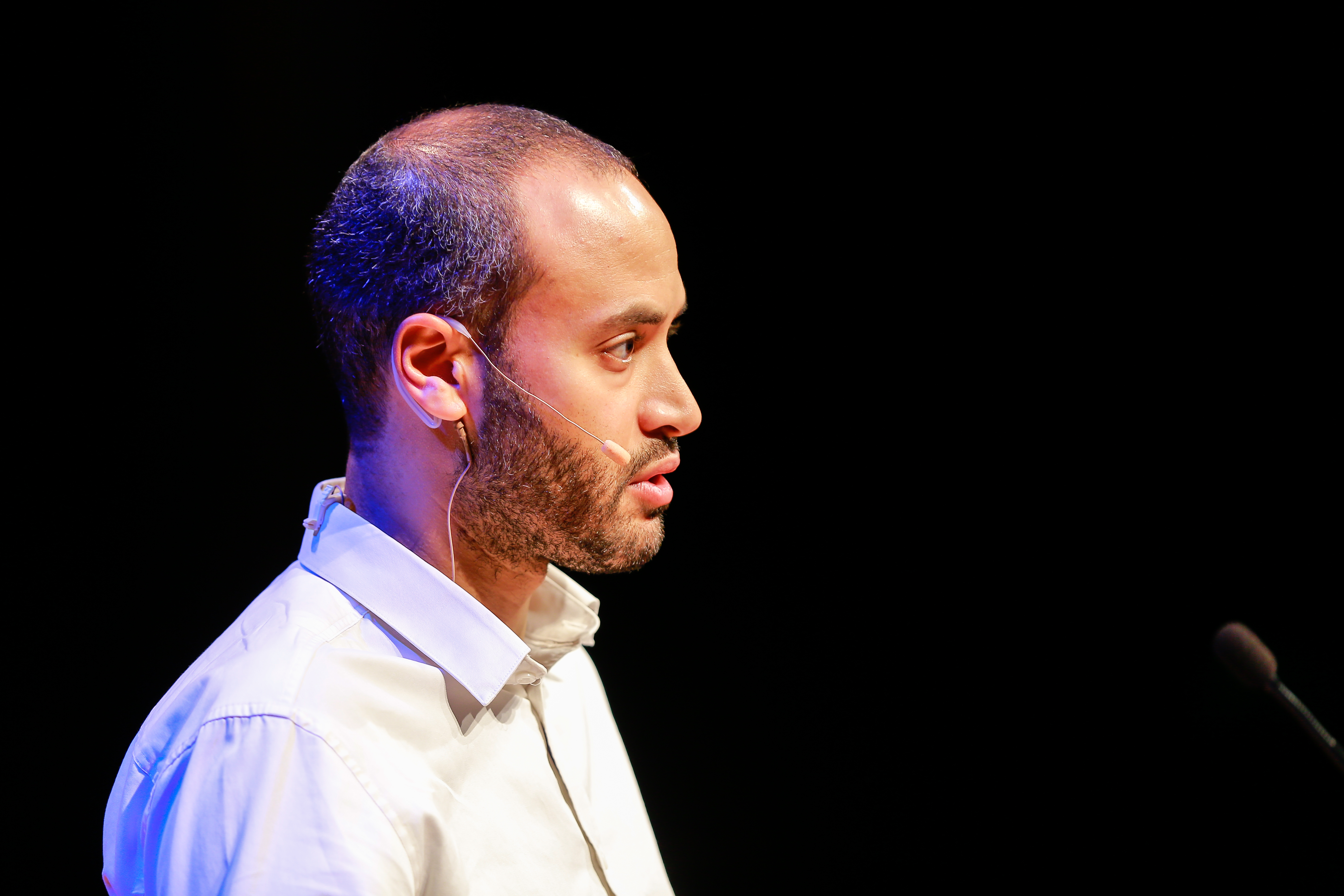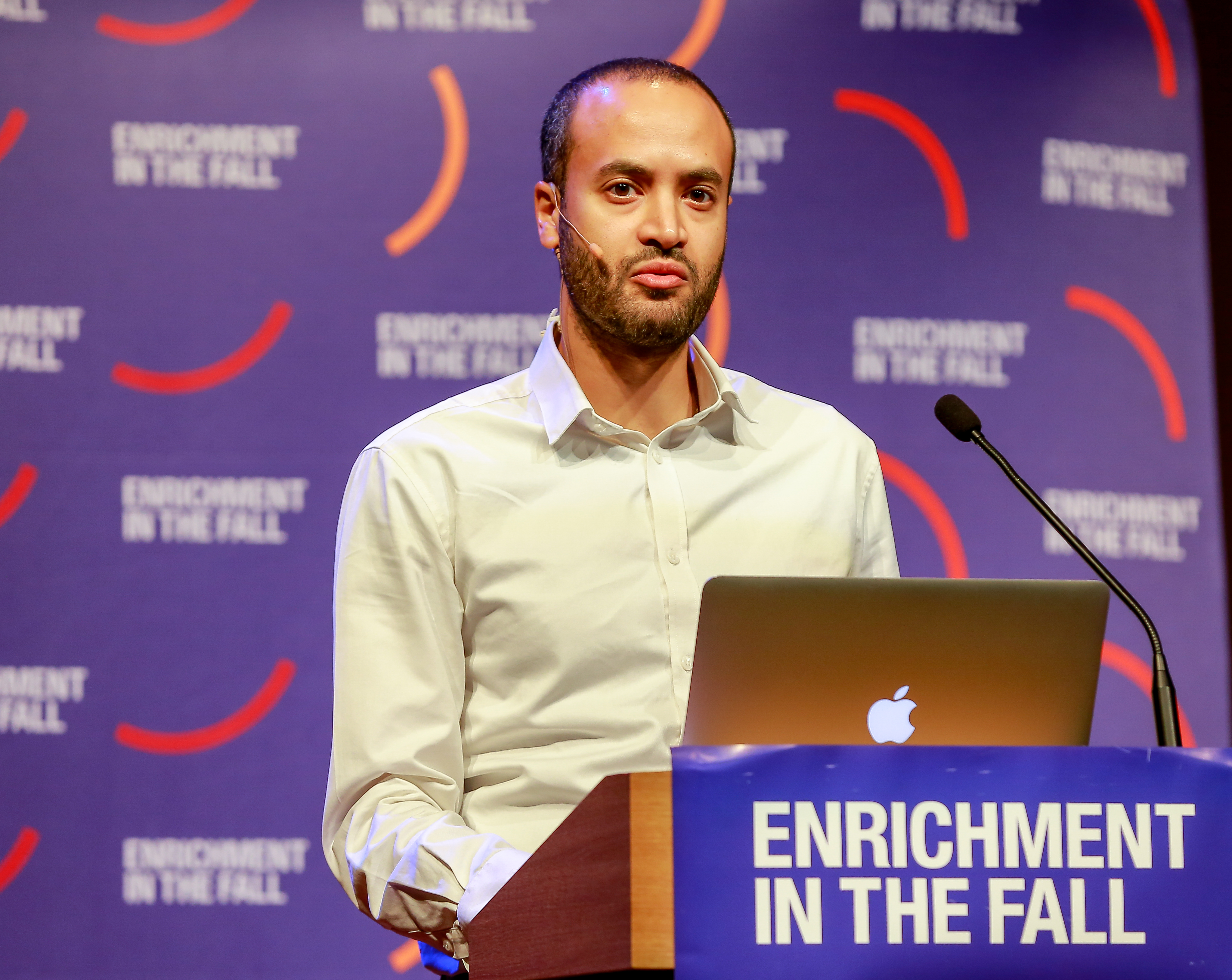A vision to change how we see

Dr. Andrew Bastawrous, CEO/co-founder of Peek, spoke to the KAUST community about life as an eye surgeon, public health doctor and researcher during his recent Enrichment in the Fall keynote lecture. Photos by Asharaf Kannearil.
According to the World Health Organisation, an estimated 253 million people worldwide live with vision impairment: 36 million are blind, and 217 million have moderate to severe vision impairment. The majority of this figure live in low-income countries where the infrastructure needed to deliver suitable healthcare is minimal.
"As a medical practitioner, there’s a difference between treating individuals and affecting populations. So I focused on a social enterprise," he said.
Bastawrous is an assistant professor of International Eye Health at the London School of Hygiene & Tropical Medicine and a research fellow at the International Centre for Eye Health. To a packed auditorium, Bastawrous described his career as an eye surgeon, public health physician, researcher, and most recently, CEO and co-founder of Peek.
Peek is both a social enterprise, as well as the name of the low-cost smartphone, ophthalmic tool, that Bastawrous helped create to bring eye care services to some of the world's most challenging and remote locations.
Challenges and solutions
“The majority of people who are blind worldwide don’t need to be. Four in every five people who are blind are blind from a condition for which there is already a cure or a preventative treatment,” Bastawrous said.
Bastawrous has worked around the world in countries such as Belize, Madagascar, Sierra Leone, Sri Lanka, Peru and Uganda. Between 2010 and 2012 Bastawrous travelled to Kenya to assess eye disease and gather general health data for the local population.
“Initially what excited me about Kenya, was that 200-300 hundred people would show up in a given place once they heard we were [the PEEK team] coming. However, this became more and more of a problem. I realised I could spend every day seeing as many people as possible, and I would hardly be seeing anyone that needed care,” Bastawrous said.
Harnessing the potential of mobile technology
Despite the lack of local infrastructure in Kenya, Bastawrous noted that mobile access, and usage, was abundant among the local populace. Mobile access that could be harnessed and used to reach the previously unreachable, and help those most in need—specifically those suffering from eye conditions, disease and curable vision loss.

“More than 80% of people in Sub-Saharan Africa have access to a mobile device, but only 50% have access to clean running water and sanitation services. I found this to be such a ridiculous statistic, but yet an opportunity. We [the PEEK team] were in the middle of nowhere, places with no running water, very poor infrastructure, no internet, yet, there was always excellent mobile coverage and availability,” Bastawrous said.
“Technology is moving at a pace that is hard to believe and access to connectivity has moved at an unbelievable pace. Those two huge issues; one of huge need, but also a huge potential, in terms of how we are now connected. It was because of those issues we developed PEEK,” he added.
Creating a game-changing mobile ophthalmic tool
In Kenya, Bastawrous realised it would be impossible for him to deal with the number of patients needing eye care, so he decided to turn his smartphone into a mobile eye clinic instead. This portable eye clinic eventually became Peek Acuity and Peek Retina, a pioneering low-cost mobile ophthalmic tool with the goal of preventing and treating vision loss. Peek uses the high-resolution screen of a smartphone to detect visual impairment and uses hardware clip-ons to modify the optics of the high-definition camera to make it possible to image inside the eye.
“The idea was to look at the test we were doing in the clinic and find a new way of doing it. Replacing it with a mobile method that could be operated, not necessarily by a specialist but by anybody," Bastawrous said.
To test sight using the Peek Acuity app, a capital letter E is shown on the phone’s touchscreen. It changes in orientation and size, with each size being a different vision level. The patient points in the direction of where the letter is facing, up, down, to the side etc., and the tester records this response by swiping the phone screen in response to the patient’s gestures. If the patient can’t tell which direction the letter is facing, the phone is shaken to indicate the letters weren’t visible to the test taker.
The app then automatically works out if the answer was right or wrong and calculates the vision score. It also depicts on the screen how the person sees the world, with their level of eyesight, and tells the user if a referral is required.
“We didn't want to create a test that was dependent on the English language because we wanted to test the vision, not literacy. The key thing is that the examiner just has to respond to the [patient’s] gesture. If the patient swipes up, I swipe up etc. The intelligence is in the phone, which is telling me whether you are getting right or wrong and it’s progressing accordingly,” he note.
The Peek app also opened up a world of previously unrealised opportunities for Bastawrous and his team regarding processing data, keeping track of respondents, areas and schools visited, managing results and so forth.
“[In the first trial of our app] 21,000 children were screened, we identified 900 with visual impairment, and that was done by 25 teachers in just nine days. What this trial showed us was that there was potential to take this to scale,” he noted.
“Bear in mind, it had taken me a year and a half to see 7,000 people. We have suddenly seen 21,000 people in just nine days,” Bastawrous emphasized.
Overcoming barriers and future plans
The Peek software has now been released as a medical device and it vision test is now available in 154 countries worldwide. The Peek Retina hardware is also available in 72 countries.
Despite all of this progress, Bastawrous outlined the barriers that still exist when it comes to treating manageable eye ailments. His team have described these barriers as; awareness (the individual that is blind is not aware there is treatment for their illness/lack of awareness from local governance); bad services; costs; distances; escorts (lack of a companion/support for the person affected); fear (myths and rumors about eye procedures); and gender (60% of those tested that are blind or unnecessarily blind are female).
“The biggest bulk of our work is not the technology; it’s the people. If we identified someone that needs treatment, and they don’t receive it, well then, we’re not making an impact. Our focus isn’t on any particular piece of technology; it’s on the whole connected system,” he said.
“We were very clear that we were not going to solve a problem by releasing apps and some gadgets, it was that whole end-to-end process that needed to work if we are going to change the lives of millions of people who are unnecessarily suffering from vision loss. it was never about apps or creating apps, it was about the queues of patients who needed treatment, who are blind, and visually impaired, and didn't need to be.” Bastawrous concluded.
At the end of his address, Enrichment in the Fall Chair, Professor Gilles Lubineau, thanked Dr. Bastawrous, and also thanked attendees, the Enrichment team, volunteers and all those who had contributed in helping to make this year’s Enrichment in the Fall program a success. Lubineau also encouraged further participation from the KAUST community in future Enrichment programs.
“The Enrichment program is a chance for the whole community to come together and to share their ideas. The success of the Enrichment programs depend on you,” Lubineau concluded.

